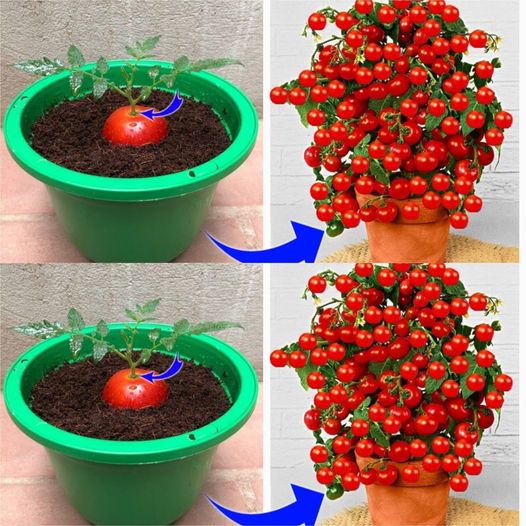ADVERTISEMENT
How to Propagate Tomatoes from Seeds
Propagating tomatoes from seeds is the most popular method, especially if you’re looking to grow a variety of tomatoes from scratch. Here’s how you can start:
Step 1: Choose the Right Tomato Varieties
Before you begin, select the type of tomatoes you’d like to grow. Consider factors like the climate in your area, space limitations, and your preferred tomato variety—whether you like cherry tomatoes, Roma, or beefsteak tomatoes. Choose seeds from reputable sources to ensure you get healthy plants.
Step 2: Start Seeds Indoors
Tomatoes should be started indoors 6-8 weeks before the last expected frost in your area. Here’s how to get started:
- Fill a seed tray or small containers with seed-starting mix (a lightweight, well-draining soil mix).
- Place the tomato seeds on top of the soil and gently press them down (don’t bury them too deep, as they need light to germinate).
- Water the seeds gently to moisten the soil.
- Keep the trays in a warm area (around 70°F or 21°C) and provide plenty of light—either by placing them near a window or under grow lights.
Step 3: Thin Out the Seedlings
As the seeds germinate and grow, you may need to thin out the seedlings by removing the weakest ones. This gives the remaining seedlings enough room to grow healthy and strong.
Step 4: Transplant Seedlings
Once your tomato seedlings have grown strong enough (with at least 2 sets of leaves), it’s time to transplant them into larger containers or directly into the garden once the outdoor conditions are suitable.
Step 5: Harden Off Seedlings
Before transplanting your seedlings into the garden, it’s essential to “harden them off.” This means gradually exposing the seedlings to outdoor conditions for a few hours each day for about a week. This helps prevent shock when you move them outside permanently.
How to Propagate Tomatoes from Cuttings
If you have an established tomato plant and want to propagate a new one without going through the entire seed-starting process, propagating from cuttings is a great option.
Step 1: Select a Healthy Tomato Plant
Choose a healthy tomato plant with strong stems and leaves. The plant should not show signs of disease or pests.
Step 2: Take a Cutting
Using clean, sharp scissors or pruning shears, cut a healthy 4-6 inch (10-15 cm) section of stem from the main plant. Make sure the cutting has at least two sets of leaves on it. Remove any leaves from the bottom 2 inches of the stem to prevent them from touching water or soil.
Step 3: Root the Cutting
There are two common ways to root your cutting:
- Water method: Place the cutting in a glass of water, ensuring the cut end is submerged. Change the water every few days. After a couple of weeks, you’ll start to see roots developing.
- Soil method: Alternatively, you can place the cutting directly into a small pot filled with seed-starting soil. Keep the soil moist but not soggy, and place the pot in a warm, sunny spot. You can cover it with a plastic bag or a small greenhouse lid to retain moisture and create a greenhouse effect.
Step 4: Transplant the Rooted Cutting
Once the cutting has developed a healthy root system (usually after 2-4 weeks), it can be transplanted into the garden or into a larger container. Make sure to harden off the cutting just as you would with seedlings before planting it outside.
Tips for Successful Tomato Propagation
- Temperature and Light: Tomatoes are sensitive to temperature and need warmth to germinate and grow. Keep the environment between 65-75°F (18-24°C). Adequate light is essential for healthy growth, so ensure your seedlings get plenty of direct sunlight or use grow lights if needed.
- Watering: Keep the soil consistently moist but not waterlogged. Tomatoes don’t like soggy roots, so ensure your containers have good drainage.
- Soil: Use a well-draining potting mix or garden soil that is rich in organic matter to help the plants thrive.
- Support: As your tomato plants grow, they’ll need support to prevent them from sprawling. Use stakes, cages, or trellises to support the plants as they mature.
Benefits of Tomato Propagation
- Cost-Effective: Propagating your own tomatoes from seeds or cuttings is a great way to save money. Rather than buying new plants every year, you can reuse seeds or cuttings from your existing plants.
- Custom Varieties: If you have a favorite tomato variety, propagating from cuttings lets you clone that plant and preserve its unique traits, like flavor or size.
- Better Control: Growing your tomatoes from scratch gives you more control over how they are cared for and ensures they are grown in the ideal environment for their success.
- Sustainability: By propagating your own tomatoes, you reduce the need to buy plants from nurseries, cutting down on plastic packaging and transportation emissions.
Conclusion
Tomato propagation is a satisfying and rewarding process that allows you to grow a fresh batch of tomatoes from seeds or cuttings. Whether you’re starting from scratch with seeds or taking cuttings from an existing plant, it’s easy to get started and watch your efforts blossom into delicious, homegrown tomatoes.
With a little care and attention, you’ll be enjoying fresh tomatoes in your garden year after year. So, grab your gloves and your garden tools—tomato propagation is waiting for you to uncover its secrets! Happy gardening!
ADVERTISEMENT
